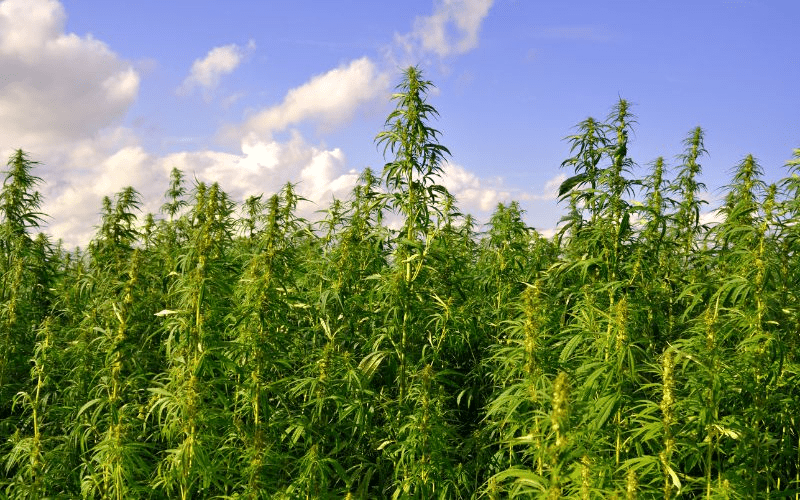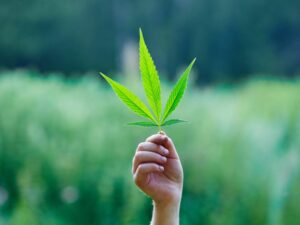An Overview of Hemp’s Legal Status in the U.S.
Hemp is a variety of the Cannabis sativa plant species that is grown specifically for industrial purposes. Unlike marijuana, another variety of the cannabis plant, hemp plants contain only trace amounts of tetrahydrocannabinol (THC), the psychoactive compound in cannabis plants that produces the “high” associated with marijuana use. In the United States, hemp has a complicated legal status that has evolved over time.

Historically, hemp was widely grown in the U.S. and farmers were even required to produce hemp in some states. However, in 1970, the Controlled Substances Act classified all forms of cannabis, including hemp, as Schedule I drugs, making it illegal to grow or possess.
In 2014, the Agricultural Act, also known as the Farm Bill, allowed for pilot farm programs to be established for the cultivation of industrial hemp for research purposes. These programs were limited to universities and state departments of agriculture, and participants in farm programs were required to obtain a permit from the Drug Enforcement Administration (DEA).In 2018, a new Farm Bill was signed into law, which removed hemp from the list of controlled substances and legalized its cultivation, processing, and sale. Under the 2018 Farm Bill, hemp is defined as any part of the cannabis plant with a THC concentration of not more than 0.3% on a dry weight basis. This means that hemp-derived products, including CBD oil, are legal at the federal level as long as they meet this THC threshold.
The Farm Bill also established a regulatory framework for the cultivation, processing, and sale of hemp products, including CBD oil, which includes testing requirements to ensure that hemp plants contain no more than 0.3% THC on a dry weight basis. Under the USDA’s regulations, licensed hemp producers must have their crops tested by a DEA-registered laboratory using validated testing methods. Samples must be taken from the flowering tops of the plants and must be analyzed for THC concentration. If the THC concentration exceeds 0.3%, the entire hemp crop must be destroyed. In addition to testing for THC concentration, some states have established their own requirements to test hemp products. For example, some states require testing for contaminants such as pesticides, heavy metals, and residual solvents. These regulations help to ensure that hemp-derived products are safe and free from harmful contaminants. Overall, the legal status of hemp in the U.S. has improved significantly in recent years, and the market for hemp products is growing rapidly. However, it is important to note that there are still some legal and regulatory challenges that hemp farmers, producers and businesses must navigate.How Hemp has Evolved from Illegal to Legal Over Time

Early Beginnings
Hemp has a long and complicated history in the United States, dating back to the colonial era. Hemp was a commonly grown crop in colonial America and was used for a range of purposes, including fiber production, papermaking, and rope production.
In the early 20th century, as part of a broader push for drug control, several states began to criminalize cannabis. This included hemp, which was classified as a controlled substance under the 1937 Marihuana Tax Act, which was a federal law that effectively banned the possession and sale of cannabis by imposing a heavy tax on those who dealt in the substance.
Industrial Hemp During World War II
During World War II, the United States government encouraged farmers to grow hemp as part of a national campaign to increase the domestic production of essential wartime materials. This was due to the fact that hemp fibers can be used to produce rope, canvas, and other materials needed for the war effort.
The federal government launched a “Hemp for Victory” campaign in 1942, which urged farmers to grow hemp and even produced a propaganda film of the same name. The campaign emphasized the importance of hemp as a strategic resource and encouraged farmers to do their part to support the war effort.
Despite the fact that marijuana and hemp were both classified as controlled substances under the 1937 Marihuana Tax Act, the federal government made an exception during the war and encouraged farmers to grow hemp for industrial purposes. Farmers were provided with hemp seeds and granted exemptions from the law in order to grow the crop.
Hemp production during World War II peaked in 1943, when farmers planted more than 150,000 acres of hemp across the United States. The crop was used to produce a wide range of essential materials, including ropes, twine, canvas, and even parachute webbing.
After the war, the federal government again cracked down on cannabis and hemp, and production of the crop declined sharply in the United States. It was not until recently that hemp has once again become a popular crop in the United States due to the growing demand for CBD products and other hemp-derived materials.
The Push for Legalization
The 1937 Marijuana Tax Act remained in effect until it was replaced by the Controlled Substances Act of 1970, which classified marijuana as a Schedule I drug (the most restrictive category) with no accepted medical use and a high potential for abuse. This classification has since been challenged and reevaluated by many, and beginning in the 1990s, a movement to legalize cannabis and hemp gained momentum in the United States. The movement was driven in part by patients suffering from chronic pain, nausea, and other symptoms who found that cannabis provided effective relief where other treatments had failed.
The movement faced strong opposition from the federal government, which continued to classify cannabis as a Schedule I drug with no accepted medical use. The federal government also launched a crackdown on medical marijuana dispensaries and growers in the early 2000s, leading to the arrest and prosecution of many people involved in the industry.
Despite this opposition, the medical marijuana movement continued to grow, and by the end of the 1990s, more than half of U.S. states had passed medical marijuana laws. This paved the way for further legalization efforts in the decades to come, including the recent trend of states legalizing cannabis for recreational use as well as the passage of the 2014 Farm Bill, which allowed for limited cultivation of hemp for research purposes.
In 2018, the Farm Bill was expanded to legalize hemp cultivation for commercial or other purposes, removing hemp from the list of Schedule I drugs and allowing for the production and sale of hemp and hemp-derived products such as CBD.
The evolution of hemp’s legal status in the United States has been shaped by a range of factors, including economic, political, and social forces. While the hemp plant was once demonized and criminalized, it is now increasingly seen as a valuable agricultural commodity with a range of potential uses and benefits.
The Current Regulatory Framework Around Hemp and Cannabis Products
The regulatory framework around hemp and cannabis products in the United States is complex and evolving. At the federal level, cannabis remains illegal under the Controlled Substances Act, which classifies it as a Schedule I drug with no currently accepted medical use and a high potential for abuse. However, in 2018, the Agriculture Improvement Act, also known as the Farm Bill, was passed, legalizing industrial hemp and its derivatives, including cannabidiol (CBD), as long as it contains less than 0.3% tetrahydrocannabinol (THC) on a dry weight basis.
At the state level, however, there is significant variation in the legal status of cannabis and hemp. As of April 2023, 18 states and the District of Columbia have legalized cannabis for adult recreational use, while 36 states have legalized cannabis for medical use. Additionally, many states have decriminalized the possession of small amounts of cannabis, reducing the penalties associated with possession.
Hemp is legal in all 50 states for commercial purposes, as long as it contains less than 0.3% THC, and many states have enacted laws to allow for the production and sale of hemp and CBD products. However, there are some states that have placed restrictions on the sale or possession of CBD products, so it is important to check local laws before purchasing or using such products.
Potential Benefits of Legalizing Hemp for Farmers and Consumers

The legalization has the potential to bring significant benefits to farmers growing hemp and consumers in the United States. Here are some of the potential benefits of legalizing hemp:
New Economic Opportunities for Farmers: Hemp is a highly versatile crop that can be used in a wide range of industrial applications, including textiles, building materials, biofuels, and food products. Legalizing hemp could open up new economic opportunities for farmers and help to diversify their income streams.
Environmental Benefits: Hemp is a sustainable crop that requires fewer pesticides and herbicides than many other crops. It also has deep roots that can help to reduce soil erosion and improve soil health. Legalizing hemp could encourage more farmers to adopt sustainable agricultural practices and help to mitigate some of the environmental impacts of agriculture.
Access to CBD Products: Hemp-derived CBD products, including oils, tinctures, and edibles, have become increasingly popular in recent years for their potential health benefits. Legalizing hemp has made it easier for consumers to access these products, which can be used to treat a range of conditions, including anxiety, pain, and inflammation.
Consumer Safety: Legalizing hemp has allowed for greater regulation of the hemp industry, which can help to ensure that hemp-derived products are safe and accurately labeled. This can provide consumers with greater confidence in the products they are purchasing and using.
Research Opportunities: Legalizing hemp for research purposes has opened up new opportunities for scientists to study the potential uses and benefits of this versatile crop. This could lead to the development of new products and technologies that could have significant benefits for farmers and consumers alike.
Overall, the legalization of hemp has the potential to bring significant benefits to farmers and consumers in the United States, from new economic opportunities for domestic production to improved environmental sustainability and consumer safety.
Possible Challenges the Hemp Industry Faces Moving Forward
The hemp industry has experienced significant growth and interest in recent years, but there are several challenges that it may face moving forward. Some of these challenges include:
Regulatory and legal uncertainties: While hemp is legal under federal regulations, there are still regulatory and legal uncertainties that may impact the industry. For example, the U.S. Food and Drug Administration (FDA) has not yet established clear guidelines for the use of hemp-derived CBD in food, beverages, and dietary supplements. In addition, there are still some states that have not legalized the production of hemp, which creates a patchwork of laws and regulations that can be difficult for businesses to navigate.
Quality control issues: With the rapid growth of the hemp industry, there are concerns about quality control and product consistency. As the industry continues to expand, it will be important to establish and enforce standards for testing, labeling, and product safety to ensure consumer confidence in hemp-derived products.
Supply chain challenges: The supply chain for hemp-derived products can be complex, with challenges related to cultivation, harvesting, processing, and distribution. Hemp producers may encounter challenges in ensuring a reliable supply of high-quality hemp biomass, and issues related to transportation and storage of hemp derived ingredients and products may also arise.
Market competition: As the hemp industry continues to grow, there may be increased competition among businesses for market share. This could lead to pressure to lower prices and potential consolidation within the industry.
Overall, the hemp industry has significant potential, but there are challenges that will need to be addressed in order to ensure its continued growth and success.
What We Can Expect from Cannabis and Hemp Law Reform in the Future
The future of cannabis law reform in America is complex and difficult to predict, as it is influenced by a range of factors such as federal law, politics, public opinion, and social attitudes. However, here are some potential outcomes that could be expected from cannabis law reform in the future:
Increased Legalization: As more states continue to legalize cannabis, it is possible that the federal government may follow suit and eventually legalize cannabis at the national level. This could lead to a significant shift in the way cannabis is regulated and perceived in the United States.
Decriminalization: Even if full legalization does not occur at the federal level, it is possible that the government could choose to decriminalize cannabis, which would reduce penalties for possession and use of the drug.
Expungement of Criminal Records: As more states legalize or decriminalize cannabis, it is likely that there will be a push to expunge the criminal records of individuals who were previously convicted for cannabis-related offenses. This could help to reduce the negative impacts of the war on drugs on affected communities.
Medical Research: As cannabis becomes more widely accepted and regulated, it is possible that there will be an increase in medical research into the potential health benefits of the drug. This could lead to the development of new cannabis-based treatments for a range of conditions.
New Business Opportunities: As the cannabis industry continues to grow and mature, it is likely that new business opportunities will emerge, such as the development of new cannabis-based products and services.
Overall, the future of cannabis law reform in America is complex and uncertain, but it is clear that the industry is rapidly evolving and expanding. As attitudes towards cannabis continue to shift and change, it is possible that we may see significant changes in the way the drug is regulated and perceived in the United States.



